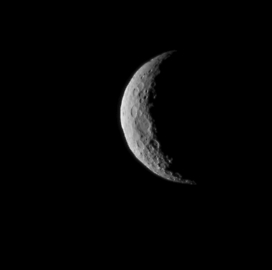 NASA and Orbital ATK confirmed that the Dawn probe has made it into orbit around the Ceres dwarf planet after a 7.5-year journey.
NASA and Orbital ATK confirmed that the Dawn probe has made it into orbit around the Ceres dwarf planet after a 7.5-year journey.
Ceres’ gravity captured the Orbital ATK-built spacecraft Friday at 4:39 a.m. Pacific time, NASA said Friday.
Dawn took off in September 2007 from Cape Canaveral, Florida, and initially encountered Vesta, orbiting the protoplanet from 2011 to 2012.
“The Dawn mission is the world’s first chance to get an up-close look at two bodies which date back to the formation of the solar system, but evolved very differently,” Mike Miller, vice president of science and environmental programs at Orbital ATK’s civil and defense satellite division, said Friday
Miller added mission scientists will use images and compositional data captured by the spacecraft to study Vesta and Ceres.
Frank Culbertson, president of Orbital ATK’s space systems group, said the spacecraft is designed with a solar electric ion propulsion technology from NASA’s Jet Propulsion Laboratory.
JPL manages the Dawn mission and the scientific team is comprised of researchers from the University of California, Los Angeles, German Aerospace Center, Italian Space Agency, Italian National Astrophysical Institute and Max Planck Institute for Solar System Research.




